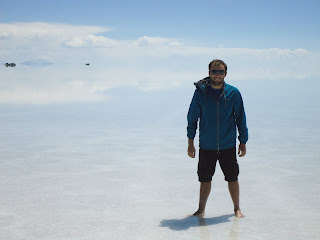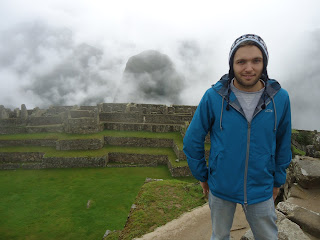jueves, 15 de marzo de 2012
Classes started!
So, classes have started, and this is what I've signed up to take:
Monday & Wednesday 1pm-2:30pm: Narratives of the monstorous in Latin America.
Monday & Wednesday 2:30pm-4pm: Gender Studies in Latin America.
Tuesday & Thursday 1pm-2:30pm: Latin American Social Movements.
Tuesday & Thursday 2:30pm-4pm: Contemporary Argentine Art.
Tuesday & Thursday 4pm-5:30pm: Argentine Cultural Studies.
I am excited and looking forward to meeting the kids in my classes, and getting into the material of these clases, most of which are extremely interesting to me.
lunes, 5 de marzo de 2012
Beautiful Bolivia
My visa into Bolivia. It was a mad-dash process, me and 3 other Americans on our bus full of mainly Peruvians, Bolivians, and Chileans crossing into Bolivia, had to get off at the border, run from office to office to get checked out of Peru, then into Bolivia, fill out an applications, pay the fee and have it be reviewed within 30 minutes before the Bus left us. Luckily we even been some of the Peruvians back to the bus. The fee? $135 USD. The experience in Bolivia? Priceless.
La Paz was a surprise, it was an extremely beautiful city, the Highest capital in the world. Snow capped mountains off in the distance. The second day, I ate at an iffy restaurant (as I was warned, that Bolivia isn't the most heigenic when it comes to food and to be very carefulo), I ended up in a La Paz hospital with an intestinal infection on an IV. However, once I got to see the city I fell inlove. The people, and the culture are so different from what I had seen (except from Northern Argentina)which is cultural similar, but much higher quality of life and better economy really stands out in comparison.
http://laalbicelestesoleada.blogspot.com.ar/2011/05/northern-argentine-road-trip.html
(A Chola, typical native woman of Bolivia, generally from the country side, but that have moved to the city)
In La Paz, I met up with Jonatan, to continue the rest of the trip through Bolivia. Our next stop would be Cochabamba, the birthplace of his father. This city has the largest Jesus Statue in the world, even bigger than the most famous one in Rio De Janeiro, Brazil. Cochabamba, was beautiful, as Uyuni, a city in the south where the world's largest salt flats are located. We took a 4x4 into the middle of the flooded Salt Flats to explore, which was completely beautiful. After 24 hours of no sleep we left Uyuni for Potosi. Potosi was the capital former Viceroyalty by the same name which occupied the majority of the lower part of South America. This city was a gold mine for the Spaniards... literally. It was the city of the largest gold and silver deposits ever discovered by the Spanish, almost the real life El Dorado.
Finally, we ended the trip in the most non-Bolivian city of Santa Cruz de la Sierra, Bolivia. I say non-Bolivian city, because its nothing at all like the rest of Bolivia. Its a city that finds its self in the low-land tropical jungles of eastern Bolivia, instead of the High cold mountains like the majority of Bolivia's cities. Santa Cruz is the most economically developed city in Bolivia, and has the largest population. The people here have almost nothing in common with the inhabitants of their capital in La Paz, they speak with a completely different accent, they have different ways of life, they eat different foods, wear different cloaths, and are all in all, very different. The city was a nice change from the cold weather we'd been experiencing in the rest of Bolivia. The coolest part of Santa Cruz, was that in our Hostel, there was a pet Tucan, that would let you hold him, pet him, and in the morning would jump on your breakfast table and still your fresh fruit.
domingo, 4 de marzo de 2012
A dream of mine came true in Peru...
Last night I arrived from my travels to Peru and Bolivia.
I first visited the surprisingly beautiful, clean, and modern city of Lima that felt strangely like a Southern California city. Modern malls over looking beaches of the Pacific Ocean complete with Starbucks, TGI Fridays, Domino's pizza, and all the American products that aren't as common to come by in Argentina due to their own internal industry, somewhat stronger than that of Peru's, and strong economic ties with imports from Europe and Brazil. However, one of the coolest "Made in Peru" products, was the delicious, yet super sweet INKA KOLA , the Peruvian answer to Coca Cola (which oddly is now owned by the Coca Cola company).
Two days after my arrival to Lima, I got on a iffy looking "Peruvian Airlines" flight with a very old plane for an hour flight to Cuzco, Peru, the Incan Capital. The flight was practically Verticle the whole time due to the fact that we were going from sea level in Lima to very high up in the Andes Mountains. Cuzco was flocked with tourists from all over the world, as expected. All heading to the famous Machu Picchu. The Andean culture started to be more noticeable, nothing at all like Lima, with a clear accent when speaking that marked that we were in the Andes, and artesans featuring llama and alpaca whool to keep warm in the high and cold altitude.
Machu Picchu was a dream come true, although complicated to get there. One has to buy the tickets to get into the sanctuary park of Machu Picchu, then by train tickets to go to the town of "Aguascalientes" also known as "Machu Picchu pueblo." To get to the train station, you must first take a 2 hour taxi ride from Cuzco to another city, going 50 or so miles an hour around winding and narrow andean roads. But in the end, it was worth it (despite getting altitude sickness at the top of the mountain, I barely remember that part, it was so beautiful).
After Machu Picchu the next stop was the town of Puno on the Peruvian side of Lake Titicaca. Spent a few days here, in a comfortable yet very cheap hotel room, trying to keep warm, and recovering from altitude sickness. The last day in Puno I headed out to the Lake and took a tour to floating islands where the Aymara people live, indigenous people that created man made islands out of Straw and Sea Weed on which they've buit their homes. They welcomed us to their Islands, and offered us food, artesans, and the kids were especially playful:
Next Stop: La Paz, Bolivia!
Suscribirse a:
Comentarios (Atom)












